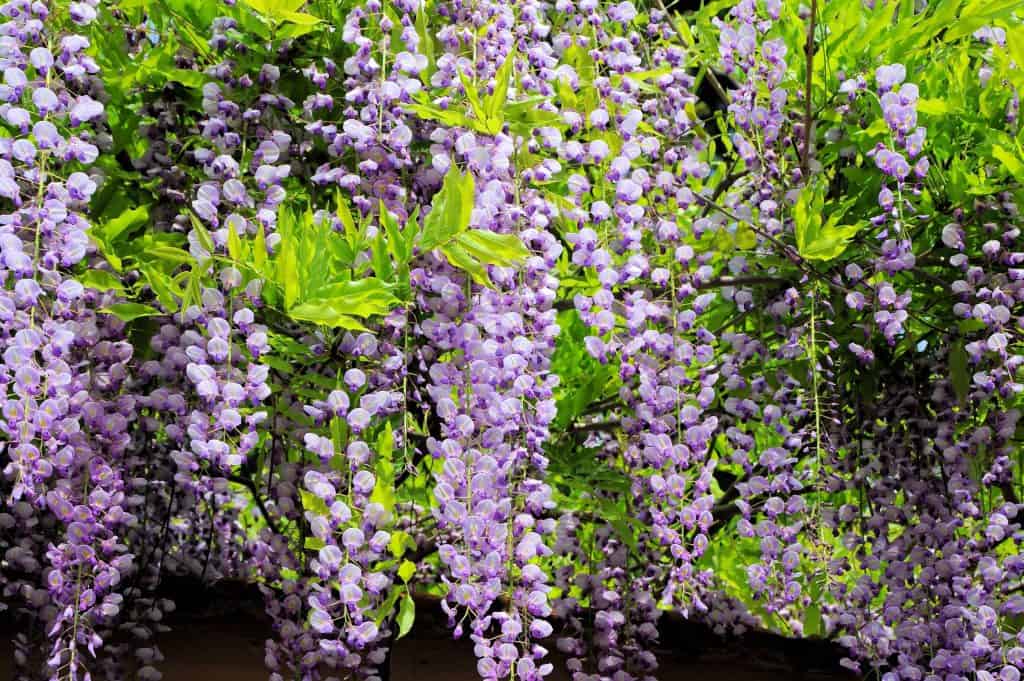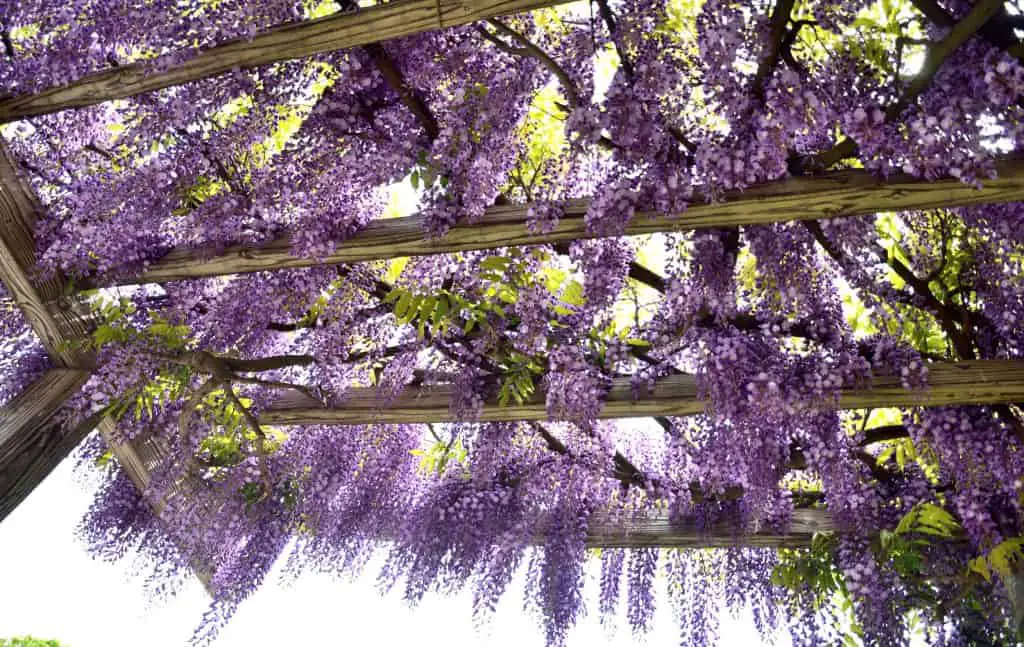Every once in a while you will come across a plant that makes you stand in awe of its majestic beauty. One of these such plants is the Japanese wisteria tree. It dazzles the eyes and delights the mind as you stare about its gorgeous climbing vine that graces arboretums and parks all over the world. The Japanese wisteria tree was brought to the United States in the 19th century and has a botanical name of wisteria floribunda. It shines with a blue to violet color to it, but can also be featured in pink and white colors. These colors come from the small flowers and bean-like pods that it produces. This climbing vine comes from Japan and has been used for ornamental use, but has become quite invasive in many parts of the country since its arrival. Furthermore, its beautiful looks can be deceiving.
The Japanese wisteria tree is highly toxic to dogs, cats, horses, humans, and other animals. All parts of the Japanese wisteria tree can cause severe discomfort if ingested. Without proper care, this award-winning royal purple will become invasive in and take over areas outside of Japan. However, with proper care and management, the Japanese wisteria tree can be a beautiful addition to many different kinds of landscapes.
One of these landscapes is the Japanese wisteria garden lives in Japan itself. Starting in April and going well into May, the Japanese wisteria flowers bloom in all kinds of colors and are turned into massive tunnels of technicolor for tourists due to its bendy frame and flexibility. These plants create an ideal photo op for anyone in the area. The Japanese gardens are in Kitakyushu, which is famous for its displays of Japanese wisteria flowers. There is also the Ashikaga Flower Park which has a massive wisteria tunnel that visitors can walk underneath. However, if you cannot make it to Japan, then you can always make your way to New York City’s Central Park or Pennsylvania’s Longwood Gardens. Both of these spots have the Japanese wisteria plants available to gaze upon.
The Japanese wisteria flower looks a bit like a vine, but does not have spines, prickles, or thorns. The leaves themselves have a leaf blade shape that can be around 200-300 mm in length. The edge of the leaf has no teeth or lobes and the leaves will drop off during the winter. The plant itself is a liana and has bark that is ridged, thin, and smooth. The plant sis between four and eight inches in width and can have a length of 10-25 inches. The twigs color can change over the seasons as it tends to bring a more brownish, gray, or orange color during the winter.

Japanese Wisteria Care
One of the key factors to caring for the Japanese wisteria vines is the pruning process. Most experts say that you will need to prune these vines at least twice a year because the Japanese wisteria flowers bloom on new growth. Pruning will manage both the size and keep the branches close to the main structure. This will allow for enjoyment of the plant without any of the dangers. In July, it is best to prune back the new growth to about six inches or after the wisteria has flowered. This is an opportune time to do maintenance on the plant and prune away any suckers that are sticking out. During the winter months, you will want to remove about half of the last six months of growth. Remember that Japanese wisteria only blooms on new wood, which is why pruning is so important.
For lightning requirements, it is important to plant Japanese wisteria in full sun with some partial shade to make sure that it produces the most amount of blooms. For reference, full sun is considered about six hours of daylight. This can pose a problem since the Japanese wisteria has a climbing growth habit and makes it more complex to deal with. If the Japanese wisteria climbs to an area without much sun, then it can damage or even kill the plant in that section, which will need to be pruned off. Creating some type of structure like an arbor will give the Japanese wisteria a new focal point, so that is does not climb a house or something that creates too much shade.
If you are looking to plant one of these Japanese wisteria plants, then it is important to make sure the soil is not overly wet. Japanese wisteria trees will not tolerate soil conditions that vary too much. They also must have ample amounts of drainage, as Japanese wisteria do not do well in wet areas. Therefore, it is imperative to create a loamy soil system that is organically rich. When considering pH levels, it is best not to have any alkaline or extremely acidic conditions. It is for the Japanese wisteria tree to keep the pH levels between the range of 6.0 and 7.0 pH.
When the Japanese wisteria tree is first planted, it will need to be watered fairly often in its first year, much like other trees and shrubs. This regular schedule of watering will help the Japanese wisteria develop stronger roots in the ground. After this first season, the Japanese wisteria tree will only need supplementary watering during the dry periods. Remember to give the Japanese wisteria trees long and deep watering that is infrequent rather than frequent watering, which can be hazardous to the wisteria.
Since the Japanese wisteria vine is from Japan, it is found in temperate climate and therefore thrives in environments that are similar to its natural habitat. This would mainly include areas that resistant to cold and yet vulnerable to high heat. The USDA hardiness range for the Japanese wisteria vine is from four to nine.
When looking at fertilizing the Japanese wisteria vine, keep this rule in mind: simple is best. If you must fertilize the vine, then use a low-nitrogen fertilizer. You will know if you are over fertilizing your Japanese wisteria plant if it is not flowering. In this case, stop fertilizing and trim the roots to scare the plant into blooming. When doing this, cut the roots in a ring around two inches away from the base trunk with a spade. This will have your Japanese wisteria vine start over from scratch, but next time, do not use so much fertilizer, if any at all. Patience is a key factor when growing Japanese wisteria plants because they may take about three years to bloom, so do not worry if the flowers do not show themselves right away. If you prune properly, you will soon enjoy brilliant blooms.
In order to propagate Japanese wisteria vines, it starts with getting the cuttings. This can easily come from the pruning process, but you can take cuttings off the plant specifically for rooting wisteria plants. It needs to be taken from the softwood, which is the wood that is still green and has not developed any woody bark. If you root the cuttings in late spring or early summer, this will give it the best chance to grow.
The Japanese wisteria vine will grow to a mature size quickly over time. As mentioned before, patience will be a key factor when growing Japanese wisteria vine. This will max out around eight inches wide and 25 feet tall. It will climb up areas too, so make sure to keep an eye on the directions it moves and get ready to prune unwanted growth.
There are a few concerns when dealing with diseases and pests for the Japanese wisteria vine. Some slight issues are fungal leaf diseases called powdery mildew and leaf spots. They both may start as yellow spots on the leaves and the powdery mildew will eventually develop a white, fuzzy coating that will take over the whole leaf. They do not spread, but they will dry out, turn brown, or give affected leaves a poor appearance.
More major things that can affect the Japanese wisteria plant are crown galls, cankers, root rot, and graft failures. These can attribute to the total collapse of the plant. Galls and cankers are unusual formations, but if the crown of the plant is affected, there is no way to help the plant and you will have to start from scratch again. Graft failures will only occur in plants that are twenty years old or more. Root rots are very preventable in younger plants and occur when the plant is water-logged. In these cases, decrease the watering, otherwise, you may have to dig up the plant, trim the root back to healthy tissues and replant it in a dryer location.
The only real pests to worry about is the wisteria borer, which is a tiny beetle that cut perfectly round holes into the woody parts of the vine. They spend most of their lives here as they hollow out tunnels and galleries where the females will lay their eggs. This can be a problem because once they are inside the tree, they are hard to control with chemicals. Your best bet is to properly water and feed your wisteria if they infestation is small, otherwise, you will need to prune off the affected sections.
Japanes wisteria can totally be a bonsai, which make it easy to maintain and control. As the Japanese wisteria can be quite invasive, it is important to follow the protocols in this article. While it does have a low severity of poison, keep it away from any house pets and children.

Types of Wisteria
There are many types of wisteria, so it is important to know what kind works for you. Each has similarities, but also some differences. Consult the list below to see the different types of wisteria.
Honbei
Otherwise known as “pink ice Japanese wisteria,” this large vine produces soft pink racemes that are tinged with lavender and are lightly scented. This type grows more slowly which makes it ideal for gardens. They grow around two or three feet a year, but still need a lot of light.
Lawrence
The Lawrence wisteria is a beautiful pale blue and sweetly scented. It has pea-like flowers up to twenty inches long and are quite densely packed. They can be grown against a house wall, arbor, or fences. It also has a dense foliage of green, pinnate leaves which consist of 13-199 lance shaped leaflets that turn yellow in the fall.
Rosea
Another gorgeous pink flowered version of the wisteria, the Rosea have flowers tipped with purple. The very long drooping clusters can be up to 24 inches long. This is perhaps the most romantic type of wisteria and can be put into a container. It is a strong climber though and has twining stems of great beauty.
Domino
Another colorful brand of wisteria, the Domino wisteria is graced with white petals with purple at the bottoms and a yolk-like yellow center with drooping clusters up to eight inches long. These bloom in succession from the base and offer a wonderful floral display with dense foliage of fresh green pinnate leaves.
Royal Purple
A long lived climber is the Royal Purple, which tends to be one of the more popular types of wisteria. This version bursts with purple flowers which can be up to twenty inches long. The Royal Purple can persist into the winter and last longer than most other types of wisteria. These are perfect fro house walls, pergolas, and trellises.
Macrobotrys
Also known as Multijuga, the Macrobotrys wisteria has dark violet markings when the leaves open in late spring or early summer. The clusters can hang up to forty-inches long and is a strong climber with twining stems. This version can be a real star in the gardens.
Kimono
With narrow, lanced shaped leaflets, the Kimono wisteria produces long racemes of scented white flowers with violet-blue clusters. Otherwise known as the “White with Blue Eye” wisteria, this vine tree is a spectacle in any garden.
Purchasing Wisteria
If you are looking for some Japanese wisteria to plant, there are many places like Lowe’s, Target, Overstock, or Walmart that sell the wisteria for low cost. Depending on what kind of wisteria you are buying, the price can range between $10-50. However, if you are looking for more cared-for plants, you might want to look at some professional garden websites that can give you additional advice. The price is not really very different from the main stores, but you can get some professional guidance from other professional spots.
If you want to start from scratch and buy seeds, you can get them from all of the aforementioned places, as well as Etsy, Michigan Bulb, and Amazon. The seeds usually are a bit cheaper, but if you do buy seeds, be sure to follow proper care directions and ask any questions that you may have.
It should be noted that, aside from the Japanese wisteria, there are also America wisteria and Chinese wisteria. The American wisteria are less invasive that the other two and bears its flowers in shorter clusters up to six inches long. The Chinese wisteria can cluster up to twelve inches long and open together. It is also not as fragrant as the Japanese wisteria. There are also not as many colors available in the American or Chinese wisteria versions as there are in the Japanese wisteria.
